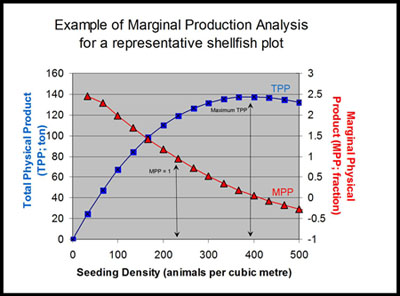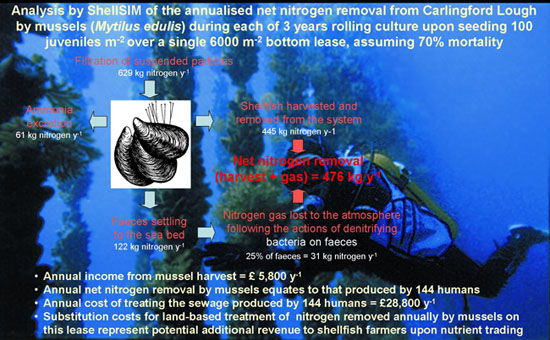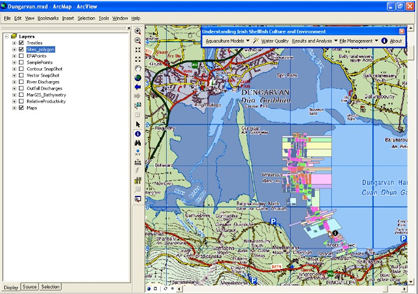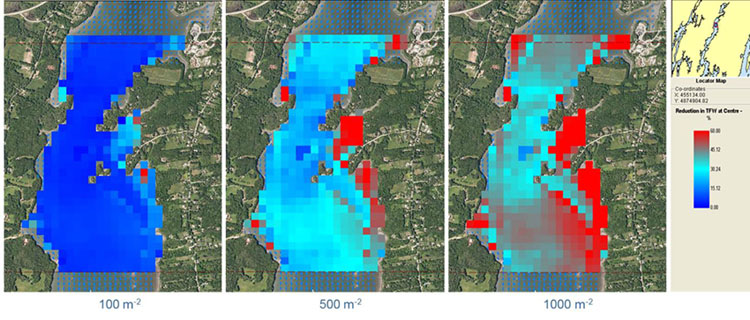Applications
Development
Originator
ShellSIM has been developed by Dr. A. J. S. (Tony) Hawkins based in part upon his research over 25 years at
Plymouth Marine Laboratory, plus a series of complimentary
collaborative Projects such as have included:
"ECASA" - EU STREP "Ecosystem Approach for Sustainable Aquaculture"; 01/12/2004 to 30/10/2007
http://www.ecasa.org.uk
"KEYZONES" - EU STREP "Ecosystem Approach for Sustainable Aquaculture"; 01/12/2004 to 30/10/2007
http://www.keyzones.com
"SPEAR" - EU INCO-DEV "Sustainable options for people, catchment and aquatic resources"; 01/12/2004 to 31/11/2007
http://www.biaoqiang.org
"SMILE" - DARDNI "Sustainable mariculture in Northern Irish lough ecosystems"; 01/10/2004 to 31/01/2007
http://www.ecowin.org/smile
"UISCE" - Irish Sea Fisheries Board “Understanding Irish shellfish culture environments”; 22/02/2007 to 30/09/2008
http://www.bim.ie/templates/reports.asp?action=detail&node_id=377&item_id=1073
"SARF012a" - Scottish Aquaculture Research Forum “Development of assimilative capacity and carrying capacity models
for water bodies utilised for marine bivalve and caged fish farming”; 01/01/2008 to 31/12 2010
http://www.sarf.org.uk/SARF012a.htm
"ShellSIM for SMILE" - Queens University Belfast (QUB) and Agri-Food & Biosciences
Institute (AFBI) “Further ShellSIM development for SMILE (Sustainable Mariculture in Northern Irish Sea Loughs)”; 01/02/09 to 28/02/2011
"NRAC" - Northeastern Regional Aquaculture Centre (NRAC) “Assessment of Environmental Effects of Oyster
Aquaculture in New England Waters”; 01/05/10 to 31/04/2012;
http://nrac.umd.edu/
"NRAC" - Northeastern Regional Aquaculture Centre (NRAC) “Shellfish STEMgis (ShellGIS) Development for
Improved Siting and Farm Management”; 01/05/12 to 31/04/2014;
http://nrac.umd.edu/
Systematic validation using standardised measurement protocols for drivers and shellfish growth during normal culture
in 14 different species has established that the common dynamic structure within ShellSIM is both robust and adaptable (illustrated above).
Throughout, care has been taken to ensure ShellSIM is practicable, flexible and affordable, engaging the basic minimum of
forcing functions (i.e. environmental drivers) required for reasonable accuracy, whilst offering the potential for optional
additional drivers as may be desired to enhance precision. For example, we have considered whether to simulate effects of
changes in the relative abundances of different phytoplankton classes, but which has not been implemented to date on the
basis of cost/benefit ratio, where very significant effort may be required to obtain appropriate driver data.
Moreover, care has been taken to ensure that Outputs are presented at whatever different levels as may be required for separate Applications. For example,
Outputs for:
- Individual Shellfish Growth, Size and Condition enable readily interpreted analyses of relative performance under different Culture Scenarios,
including prospective analyses of culture location and species selection;
- Weight-Standardised Physiological Rates may be useful for scientific comparisons;
- Cumulative Environmental Impacts of Individual Shellfish provide quantification that is easily presented and visualised;
- Density-dependent Environmental Impacts per Shellfish Population are expressed as immediately appropriate for exchange with other models such as of
hydrodynamics, biogeochemistry and environmental status;
- Population Dynamics account for recruitment, mortality and harvesting profiles, simulating Standing Stock and associated risks in real time, such as may
be of interest in negotiating aquaculture insurance (for FAO review, click on the thumbnail below); and
- Culture Practise Outputs present collective yield and environmental impact for the Culture Area as a whole, integrating for any coincident Species in
adjacent Sectors, towards analyses of marginal profitability (i.e. Ferreira et al. 2007).
For example, in the Marginal Productivity Analysis illustrated below for
a representative shellfish plot, ShellSIM predicts maximum Total Physical Production (TPP) of about 137 total fresh tons harvested when shellfish are seeded
at densities slightly below 400 animals per cubic metre. Shellfish production declines at higher densities in response to food limitation. Obviously,
maximising the tonnage produced does not maximise profits, which will depend upon the interplay between relative effort, costs and revenue. Marginal Physical
Product (MPP) is computed as the change in TPP (tons total fresh weight of shellfish harvested) divided by the associated change in seeding effort (tons
total fresh weight of seed deployed), both changes being computed relative to the same previous seeding density. In terms of biomass alone, then when the
increase in TPP declines below the increase in tons seeded (i.e. APP is less than 1), there may clearly be an issue with profitability, and which occurs in
the example below at a far lower seeding density than that at which TPP is maximised. But of course the marketable product would normally have more value per
unit biomass than the seed, such that marginal analysis needs to be weighted with those respective values to compute the Value of the Marginal Product (VMP),
enabling the producer to recognise and thus earn more profit than if basing decisions on total production or total revenue alone (Jolly and Clonts, 1993).

All fluxes have been converted to those for total or organic carbon, nitrogen and/or phosphorus, whether for seston, shellfish tissue and shell, excreta or
biodeposits, the latter being resolved between true faeces and pseudofaeces. This range of Outputs is designed to facilitate prediction of faecal settlement rates
and the resulting biodeposition footprints around shellfish farms (Weise et al., 2009; Gilesa et al., 2009), including the impacts of that biodeposition upon
benthic processes and status (Newell, 2004).
Outputs are also ready to feed into simulation of nutrient regeneration; for >20% of the nitrogen in shellfish faeces is lost to the atmosphere as nitrogen
gas following the actions of denitrifying bacteria (Newell, 2002). This is an area of emergent interest, for that loss as nitrogen gas from faecal biodeposits
must be added to nitrogen removed within tissue and shell upon harvest to compute the total nitrogen removed by shellfish in coastal waters or pond systems. With
these figures to hand, it has been proposed that any commercial enterprise contributing nitrogen to a sensitive system might offset nitrogen loads upon buying
loading compensation from shellfish growers as a means of nutrient trading, or that shellfish farmers may receive subsidies for nitrogen removal, either of which
may help to increase both the production and profitability of shellfish aquaculture. By these means, shellfish farms may be used to help reduce nutrient
concentrations in coastal waters, as a bioextractive process effecting water quality remediation (Rice, 1999; Golen, 2009; Wilcox, 2009).

Regulatory Implementation within the context of sustainable aquaculture
The above Project named "Ecosystem Approach for Sustainable Aquaculture" (ECASA) produced the
internet-based ECASA Toolbox, where ShellSIM
is promoted among other tools tested for use by industry, regulators and managers engaged in marine
aquaculture environmental impact assessments. There, ShellSIM outputs are identified as relevant to
the following indicators of environmental status or impact (i) shellfish growth rates and shellfish
condition (i.e. meat weight/shell wt or length), (ii) water quality measures such as of chlorophyll a
and dissolved nitrogen, which are eaten and excreted by shellfish, respectively, and (iii) benthic
measures of sediment organics, species composition and system processes, such as are influenced by
the pseudofaeces and true faeces deposited by shellfish.
The above Project named “Sustainable Mariculture in Northern Irish Lough Ecosystems”
(SMILE) produced an integrated
hydrodynamic and biogeochemical modeling tool that uses ShellSIM validated for local shellfish species,
and which tool is currently being applied and developed by Queen’s University Belfast and the
Agri-Food and Biosciences Institute (AFBI) to help structure growth of the
Mytilus edulis and Crassostrea gigas shellfish
aquaculture industry in Northern Ireland.
A follow-on Project enabled calibration and validation of ShellSIM for
Modiolus modiolus, Ostrea edulis and Pecten maximus,
for application within integrated SMILE product, including by the
Modiolus Restoration Research Group (MRRG) based at
Queen’s University
Marine Laboratory in Portaferry, Northern Ireland, for the
Modiolus Restoration Plan which aims to restore the Strangford Lough Special Area of Conservation
(SAC) back to Favorable Conservation Status (FCS).
The above Project named "Sustainable Options for People,
Catchment and Aquatic Resources" (SPEAR) produced integrated models that included ShellSIM validated for
local shellfish species, for managers of two important coastal systems in China to examine the consequences
of development for biodiversity, conservation, habitat protection, water quality and aquaculture yield,
including profit maximisation through the use of marginal analysis.
The above project named "Understanding Irish Shellfish Culture Environments" (UISCE) integrated ShellSIM
calibrated for local shellfish species within
MarGISTM, a user-friendly management tool that saves time and money by integrating existing
numerical models into a GIS framework designed for non-modellers to execute model runs, visualise and report
on simulation results within a single environment. MarGISTMhas been adopted by the Northwest Region
of the United Kingdom Environment Agency as ‘best practice’ in fulfilling their obligations under the
EU Habitats Directive, and has been developed by
MarCon and Bord Iascaigh
Mhara (BIM) to investigate the aquaculture carrying capacity potential of a number of bays around Ireland,
including as a decision support tool for the management of the national inshore shellfisheries spawning grounds,
whilst helping State Agencies meet the requirements of various EU Directives focused on environmental management
and protection. For immediate access to an online demonstration of ShellSIM’s contribution to the MarGIS
aquaculture management system, click on the thumbnail below.

Demonstration of ShellSIM's contribution to MarGISTM
Within the above Project entitled “Development of Assimilative Capacity and Carrying Capacity Models for
Water Bodies Utilised for Marine Bivalve and Caged Fish Farming” (SARF012a), ShellSIM has been integrated
with hydrodynamic and biogeochemical models as an application to screen for the environmental capacity to
assimilate aquaculture waste in Scottish lochs and voes, taking into account synergies between shellfish
and finfish farming. Planned users are
Marine Scotland Science (MSS) and the
Scottish Environment Protection Agency (SEPA).
Within the above Project entitled “Shellfish STEMgis (ShellGIS) Development for Improved Siting and Farm Management” (NRAC),
ShellSIM has been used in the development of
SHELLGIS, as a practical tool to help bivalve mollusc farmers select good sites and manage them for optimal growth rates and seed
to harvest yields. As an application of STEMgis,
ShellGIS analyses shellfish farming practices in space and time, accounting for the interactive effects of seeding density, culture
type and hydrodynamics. Recent improvements include detailed flow models for both surface cages and on the bottom, each as a
function of location, seeding density, seed size and time of year seeded (Newell et al., 2012 a, 2012b, 2013a, 2013b, 2013c).
To help balance aquaculture development and other uses of the coastal zone, ShellGIS also draws upon
SIMCOAST, a fuzzy logic rule-based expert system based
upon stakeholder inputs, towards better-informed marine spatial planning
(Newell et al., 2013d).

Percentage reduction in Crassostrea virginica growth simulated by ShellGIS as live weight at the center of 1 hectare bottom culture in Damariscotta River, Maine, as a function of seeding density following normal culture from June to October
The Aquaculture and Fisheries Department of
Food and Agriculture Organization of the United Nations (FAO) present
14 case studies, based upon geographic mapping tools, which are judged to have
contributed to solving important issues that affect the sustainability of aquaculture and inland
fisheries. The utility and relevance of ShellSIM is illustrated here, as the sole means of simulating
shellfish within 2 (i.e. Bacher et al. 2003, MarGISTM 2009) of those 14 tools.